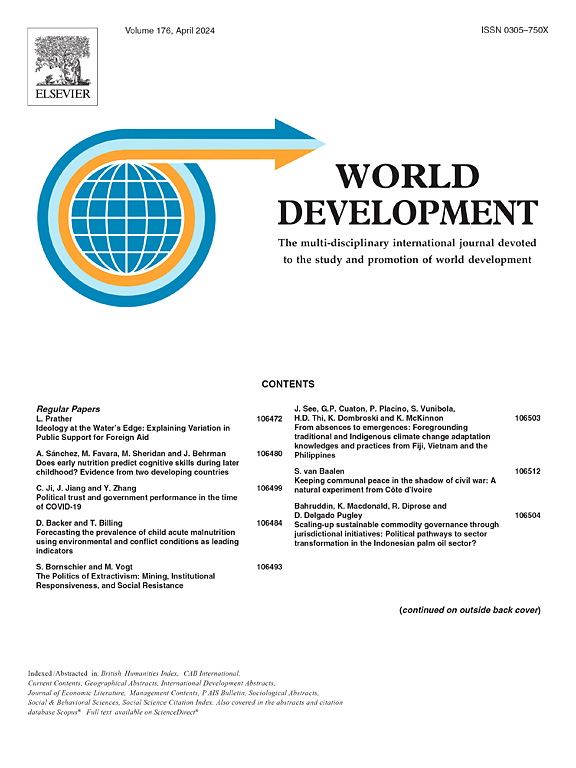印度性别比与生育偏好:一项纵向分析
IF 5.4
1区 经济学
Q1 DEVELOPMENT STUDIES
引用次数: 0
摘要
计划生育政策和根深蒂固的父权规范导致了印度男女比例的高度失衡。虽然重男轻女对性别比的影响已被大量研究,但男性失衡的性别比对女性生育偏好的影响仍未得到充分探讨。本文结合不同的纵向数据集(印度人口普查和IHDS小组家庭调查),对地区一级性别比对妇女生育偏好的影响以及这种关系的嵌套路径进行了原始的实证分析。个体和时间固定效应回归表明,地区男性过剩对女性期望的男孩数量有负向影响。这些发现的稳健性在进行多次检查后得到证实,包括利用印度气象部门(1952-2011)的温度数据控制内生性。潜在路径的调查表明,较高的地区男女比例可能使性别规范和婚姻市场更有利于女性(通过提高结婚决策权和结婚年龄,降低嫁妆价格和家庭暴力接受程度)。我们的结论是,在根深蒂固的父权规范背景下,这种自我纠正过程塑造了性别比例和重男轻女之间的关系,阻碍了性别平等。本文章由计算机程序翻译,如有差异,请以英文原文为准。
Sex ratio and fertility preferences in India: A longitudinal analysis
Birth control policies and entrenched patriarchal norms have contributed to a highly imbalanced male/female ratio in India. While the impact of son preference on the sex ratio is largely studied, the consequences of a male-skewed sex ratio on women’s fertility preferences remain underexplored. Merging different longitudinal datasets (Indian Census and IHDS panel household survey), this article provides an original empirical analysis of the effect of district-level sex ratios on women’s fertility preferences and the nested pathways of this relationship. Individual and time fixed-effects regressions show that district-level surplus of men negatively affects women’s desired number of sons. The robustness of these findings is confirmed after conducting multiple checks, including controlling for endogeneity by leveraging temperature data from the India meteorological department (1952–2011). The investigation of potential pathways shows that a higher district male/female ratio may make gender norms and the marriage market more favorable to women (via an increase in decision-making power and age of marriage, and a decrease in the dowry price and domestic violence acceptance). We conclude that this self-corrective process which shapes the relationship between sex ratio and son preference in contexts of entrenched patriarchal norms, hinders gender equality.
求助全文
通过发布文献求助,成功后即可免费获取论文全文。
去求助
来源期刊

World Development
Multiple-
CiteScore
12.70
自引率
5.80%
发文量
320
期刊介绍:
World Development is a multi-disciplinary monthly journal of development studies. It seeks to explore ways of improving standards of living, and the human condition generally, by examining potential solutions to problems such as: poverty, unemployment, malnutrition, disease, lack of shelter, environmental degradation, inadequate scientific and technological resources, trade and payments imbalances, international debt, gender and ethnic discrimination, militarism and civil conflict, and lack of popular participation in economic and political life. Contributions offer constructive ideas and analysis, and highlight the lessons to be learned from the experiences of different nations, societies, and economies.
 求助内容:
求助内容: 应助结果提醒方式:
应助结果提醒方式:


